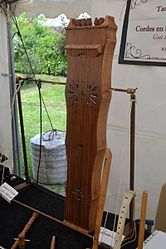Psalterium (instrument)
 |
|
| Other names | Psaltery |
|---|---|
| Classification | String instrument |
| Playing range | |
| Drone (music) | |
| Related instruments | |
| Hammered dulcimer, Tabor, Psaltery, Zither, Aeolian harp | |
A psalterium /sɒlˈtɪəriəm/, or tambourin à cordes, is a stringed musical instrument, the name of which means the same thing as the one of psaltery. In specific usage, this name denotes a form of long psaltery that is tuned to provide drone chords. Sometimes called a "string drum," though not to be confused with a friction drum also called a "string drum," it is usually used as rhythm accompaniment with a form of tabor pipe. It is also known as tambourin de Béarn or Tambourin de Gascogne in French, ttun-ttun [cunˈcun] (for the sound emitted) in Basque, salmo in Spanish, and chicotén in Aragonese.
Some authors have called into question the inclusion of the Pyrenean stringed drum under the name of psalterium.
It is slung on the arm or over the shoulder of a player who uses the same hand to play the pipe, while striking the strings with a linen covered stick held in the other hand. The 6 strings (3 sets) are most often tuned in octaves that match the keynote of the tabor pipe, and can be played pianissimo as well as forte.
The instrument is currently widespread in the western Pyrenees, and it bears the hallmark of the territory. Apparently invented in the 15th century, it came into use in the Pyrenees, where it took hold. It is popular in the easternmost Basque province of Soule (Zuberoa), where it provides along with the three hole flute (xirula) the necessary musical background for traditional dance performances and the carnival set of performances called maskarada, which takes place on a yearly basis in different villages of the former viscounty.
...
Wikipedia
